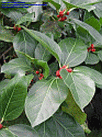





|
 A. Fortune
A. Fortune
Plant Family: Moraceae, the Fig family, other members include the edible Fig (Ficus carica), Rubber Tree (Ficus elastica), and Breadfruit (Artocarpus incisa).
Description: Huge, imposing, spreading tree, up to 30 m (100 ft) tall; “trunk” is a large mass of lignified adventitious aerial roots; other aerial roots hang from branches and rapidly take root on reaching ground, then develop into independent stems supporting the tree; wood soft and porous with milky, sticky latex, common to Moraceae family; shiny, leathery leaves up to 20 cm (8 in) long; very small, separate, male and female flowers; fruit a red berry without stem in leaf axils, about 1.5 cm diam; fruit is not edible for humans but is eaten by birds and monkeys; largest banyan tree known is on island of Sri Lanka and has 350 large trunks and over 3,000 small ones.
Natural Habitat: Tropical and semi-tropical regions with moderate to ample rainfall; in wild, tree grows when birds drop seeds into top branches of other trees, the seeds sprout in the treetops and the Banyan begins life as epiphyte on host tree, gathering its nourishment and water from the air as branches develop; these send roots down to the ground which support tree, then enlarge into trunks and develop new branches; in time, Banyan kills host tree by strangling it and becomes independent.
Origin and Distribution: Native of India, now dispersed throughout tropics and semi-tropics.
Uses: Primarily ornamental and shade.
Indigenous Legends: Hindus consider the Banyan sacred and a sin to destroy it; in ancient Arabia, tree served as place for holding council and negotiating treaties; among many cultures, tree is revered as tree of justice; Asian merchants, or banias, conducted business under these large trees, considering a contract made in their shade binding; sometimes as many as a thousand banias collected between the plunging roots of one tree, as if it were a stock exchange, leading the British to name “the tree of the banias,” the banyan.
References:
Alan Eyre. The Botanic Gardens of Jamaica. Andre Deutsch, London 1966
H.F. Macmillan. Tropical Planting and Gardening, Macmillan, London 1956
Dorothy P. Storer. Familiar Trees and Cultivated Plants of Jamaica. Macmillan, London 1964
haryana-online.com, Haryana, India, 2004
Rami Sajdi. Desert Land. acacialand.com, Jordan, 2004
|



